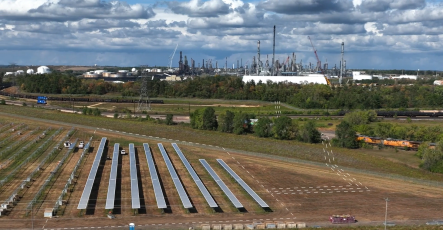Refiners and petrochemical manufacturers are proving that using oil and gas while reducing emissions is not a zero-sum game. By integrating cutting-edge technologies and developing lower emissions products, they are enabling global communities to enjoy the benefits of life-enhancing fuels and petrochemicals, all while significantly lowering emissions across the economy. This transformative approach is paving the way for a future where energy efficiency and environmental stewardship go hand in hand. Examples of these technologies are highlighted below:
Renewable Power
What is it?
Renewable power refers to energy generated from natural sources that don’t run out and can be used over and over again. Sources of renewable power include sunlight, wind, water, biomass and geothermal heat. Renewable power sources are continuously available and produce little to no greenhouse gas (GHG) emissions.
How is it used?
U.S. fuel and petrochemical manufacturers are using renewable energy to power their facilities and reduce GHG emissions in the process.
For example, Flint Hills Resources announced it will build its second company-owned solar installation at its Corpus Christi West refinery. The 27-MW solar installation will include approximately 56,700 panels in what is believed to be the first solar project in Texas to provide onsite, self-generated electricity directly to a refinery. The company also began full operation of its 45 MW solar system at its Pine Bend, Minnesota refinery in early 2024, currently the largest of its kind, providing direct input to an operating refinery.
Carbon Capture
What is it?
Carbon capture technologies, including carbon capture, utilization and storage (CCUS), are a suite of technologies that capture carbon dioxide (CO2) emissions from the atmosphere. The carbon reduction potential of these technologies is huge. In fact, the United Nations (UN) Intergovernmental Panel on Climate Change says that carbon capture and storage could reduce up to 15 percent of global emissions by 2040, and without it, global decarbonization efforts are estimated to double in cost.
How is it used?
The broader oil and gas industry deploys carbon capture in various ways. Some upstream oil and gas producers capture CO2 from their drilling operations and then utilize it for enhanced oil recovery to improve their extraction rates. Refiners and petrochemical manufacturers are capturing CO₂ from hydrogen production units, steam methane reformers and fluid catalytic crackers, for example, to reduce their emissions. Other companies are joining together to create carbon capture hubs where multiple companies can share equipment, pipeline systems and underground storage locations to maximize emissions reduction in key geographies. Captured, CO2 is used for different purposes like growing plants, making fuel or creating plastics.
ExxonMobil, for instance, has over 30 years of experience with CCUS — and is, in fact, responsible for about 40% of all CO₂ captured worldwide since 1970. In 2023, ExxonMobil expanded its CCUS capabilities by agreeing to purchase Denbury, which provides ExxonMobil with the largest CO₂ pipeline network in the U.S. — including nearly 925 miles of pipeline in Texas, Louisiana and Mississippi, one of the largest markets for CCUS.
The American Fuel & Petrochemical Manufacturers (AFPM) is the leading trade association representing the makers of the fuels that keep us moving, the petrochemicals that are the essential building blocks for modern life, and the midstream companies that get our feedstocks and products where they need to go. We make the products that make life better, safer and more sustainable — we make progress.


